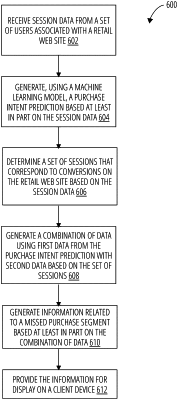| CPC G06Q 30/0281 (2013.01) [G06Q 30/0201 (2013.01); G06Q 30/0202 (2013.01); G06Q 30/0641 (2013.01)] | 30 Claims |

|
1. A method, comprising:
receiving session data from a set of users associated with a retail website, the set of users comprising anonymous users and the retail website comprising a website offering a set of products for purchase through a set of actions performed by a user;
generating, using at least one machine learning model, a purchase intent prediction based at least in part on the session data, generating the purchase intent prediction comprises:
determining, using a training set of data, a first set of sessions that correspond to sessions that ended in conversions, the training set of data comprising different session data from a different set of users associated with the retail website;
training, based on unsupervised learning, a classifier using the first set of sessions that correspond to sessions that ended in conversions;
training a particular model based on the training of the classifier, the particular model modeling a distribution of the first set of sessions that ended in conversions, the particular model comprising a 1-class classification model, wherein an output of the 1-class classification model comprises a probability that a particular session belongs to a segment of sessions that ended in conversions;
determining, using the 1-class classification model, that a particular set of sessions has a particular probability of belonging to the segment of sessions that ended in conversions;
determining that the particular set of sessions did not end with conversions;
based on the particular probability and determining that the particular set of sessions did not end with conversions, generating first data indicating that the particular set of sessions have been assigned to a missed purchase segment;
determining a set of sessions that correspond to conversions on the retail website based on the session data, the set of sessions being different from the particular set of sessions that did not end with conversions;
generating a combination of data using the first data from the purchase intent prediction with second data based on the set of the sessions that correspond to a set of conversions, the combination of data comprising a purchase intent segment and the missed purchase segment, the missed purchase segment comprising a subset of users from the purchase intent segment, the purchase intent segment comprising a subset of a set of non-buyers and a set of buyers;
generating information related to the missed purchase segment and the purchase intent segment based at least in part on the combination of data, the missed purchase segment comprising a group of users that intended to purchase one or multiple items or products but did not complete a purchase prior to an end of a corresponding session, the purchase intent segment including a second group of users that includes the set of buyers and a third group of users that includes the subset of the set of non-buyers; and
providing the information as a set of graphical elements for display on a client device, the set of graphical elements including a first graphical element as the missed purchase segment, and a second graphical element as the purchase intent segment.
|